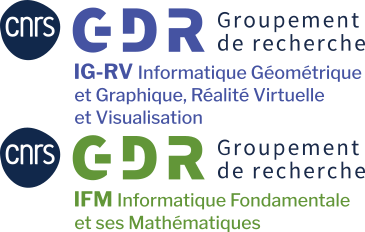Présentations LonguesSession 11h à 12h30Hardness of computing quantum invariants of 3-manifolds with restricted topologyde Henrique Ennes
Introduction to Geometric Algebrade Enzo HarquinL’algèbre géométrique, ou algèbre de Clifford, offre un cadre unifié pour représenter et manipuler des objets géométriques de toute dimension. Des objets les plus simples comme les scalaires et les vecteurs, jusqu’aux bivecteurs et aux entités de dimensions arbitraires, elle permet de capturer à la fois la magnitude et l’orientation grâce à des opérations comme le produit scalaire, le produit extérieur et le produit géométrique. Cette présentation introduit ces concepts fondamentaux à travers des exemples intuitifs en 2D et 3D. Elle se conclut par une ouverture vers des algèbres plus avancées, telles que PGA (Projective Geometric Algebra), CGA (Conformal Geometric Algebra) et CCGA (Conic Conformal Geometric Algebra), etc., qui élargissent ce formalisme en permettant de représenter de façon unifiée les intersections, les transformations et les courbes de degré arbitraire. Projet Fractosde Charles-Adèle Desormeaux Propriétés différentielles de surfaces fractalesde Clément Poull Many domains require non-smooth surface geometries: industry with quality control or CAD, computer graphics with geometric texture generation or terrain synthesis... Fractal models like the Iterated Function Systems (IFS) model are capable of generating self-similar multiscale objects, allowing the generation of a large variety of surfaces with non-standard geometries. Preceding works on IFS have demonstrated how to compute and control pseudo-tangents (defined by two different directions for the right and left tangents at each point) everywhere on these nowhere differentiable geometries. The second-order differential form, that provides even more control possibilities, was only proposed for fractal curves via the introduction of the Differential Characteristic Function (DCF). In this paper, we introduce the Surface Differential Characteristic Function (SDCF), an analytical form that helps characterising and analysing the differential properties (tangents and curvatures) of tensor product non-differentiable surfaces. We use the SDCF to compute the pseudo-curvatures for surfaces generated by tensor products of IFS. Session 14h à 14h40Discrete Torsion of Connection Forms on Simplicial Meshesde Théo Braune
Paramétrisation semi-globale en temps réel de surfaces implicitesde Baptiste Genest Les représentations implicites des formes sont largement utilisées en infographie, car elles offrent de nombreuses propriétés précieuses pour la conception, la modélisation et l'animation. Cependant, leur nature implicite et volumétrique rend fondamentalement difficile l'application de textures 2D. Nous proposons une méthode permettant de calculer des paramétrisations semi-globales, ponctuelles et parallélisables de surfaces implicites, à des fins de texturation, de rendu et de modélisation. Notre méthode définit non seulement des parcelles locales de paramétrisation, mais permet également de fusionner plusieurs parcelles adjacentes en de larges zones spatialement cohérentes, conformes à la géométrie. Implémentée dans des shaders sur un pipeline de traçage de sphères, notre méthode permet aux utilisateurs de modifier les champs UV avec une visualisation en temps réel. Nous démontrons comment ajouter des détails de rendu (textures, normales, déplacements, etc.) en utilisant notre paramétrisation, ainsi que des quantités diffusantes sur la surface, et comment étendre les outils de modélisation grâce à des cartes de coque implicites. De plus, les objets texturés restent implicites et peuvent continuer à être utilisés dans un pipeline de modélisation. |


